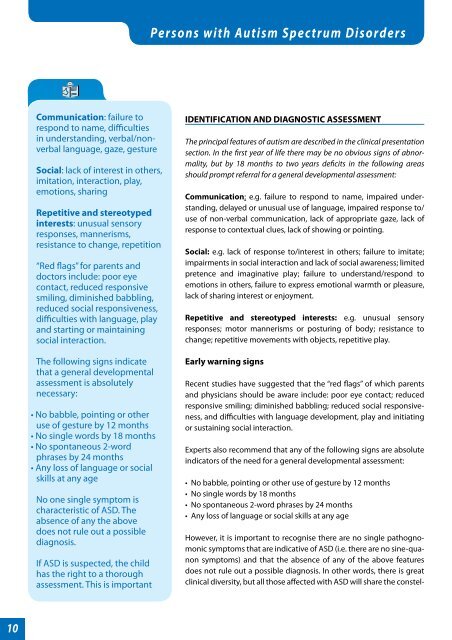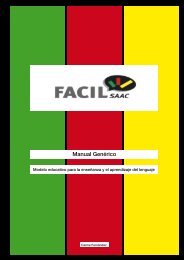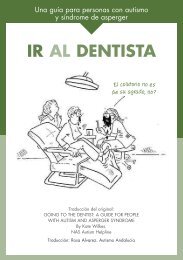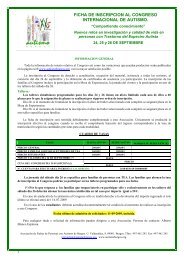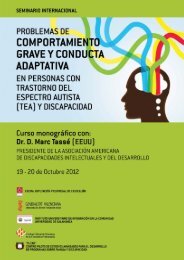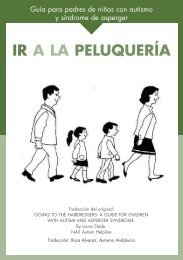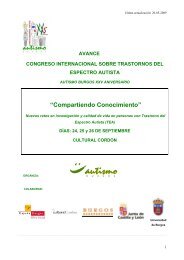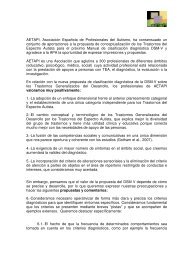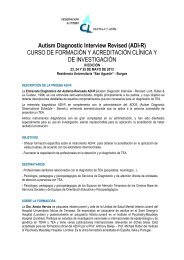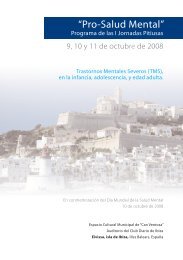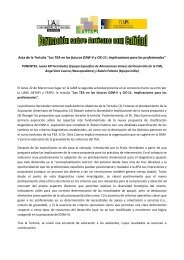persons with autism spectrum disorders - Aetapi
persons with autism spectrum disorders - Aetapi
persons with autism spectrum disorders - Aetapi
You also want an ePaper? Increase the reach of your titles
YUMPU automatically turns print PDFs into web optimized ePapers that Google loves.
10<br />
Communication: failure to<br />
respond to name, difficulties<br />
in understanding, verbal/nonverbal<br />
language, gaze, gesture<br />
Social: lack of interest in others,<br />
imitation, interaction, play,<br />
emotions, sharing<br />
Repetitive and stereotyped<br />
interests: unusual sensory<br />
responses, mannerisms,<br />
resistance to change, repetition<br />
“Red flags” for parents and<br />
doctors include: poor eye<br />
contact, reduced responsive<br />
smiling, diminished babbling,<br />
reduced social responsiveness,<br />
difficulties <strong>with</strong> language, play<br />
and starting or maintaining<br />
social interaction.<br />
The following signs indicate<br />
that a general developmental<br />
assessment is absolutely<br />
necessary:<br />
<br />
use of gesture by 12 months<br />
<br />
<br />
phrases by 24 months<br />
<br />
skills at any age<br />
No one single symptom is<br />
characteristic of ASD. The<br />
absence of any the above<br />
does not rule out a possible<br />
diagnosis.<br />
If ASD is suspected, the child<br />
has the right to a thorough<br />
assessment. This is important<br />
Persons <strong>with</strong> Autism Spectrum Disorders<br />
IDENTIFICATION AND DIAGNOSTIC ASSESSMENT<br />
The principal features of <strong>autism</strong> are described in the clinical presentation<br />
section. In the first year of life there may be no obvious signs of abnormality,<br />
but by 18 months to two years deficits in the following areas<br />
should prompt referral for a general developmental assessment:<br />
Communication: e.g. failure to respond to name, impaired understanding,<br />
delayed or unusual use of language, impaired response to/<br />
use of non-verbal communication, lack of appropriate gaze, lack of<br />
response to contextual clues, lack of showing or pointing.<br />
Social: e.g. lack of response to/interest in others; failure to imitate;<br />
impairments in social interaction and lack of social awareness; limited<br />
pretence and imaginative play; failure to understand/respond to<br />
emotions in others, failure to express emotional warmth or pleasure,<br />
lack of sharing interest or enjoyment.<br />
Repetitive and stereotyped interests: e.g. unusual sensory<br />
responses; motor mannerisms or posturing of body; resistance to<br />
change; repetitive movements <strong>with</strong> objects, repetitive play.<br />
Early warning signs<br />
Recent studies have suggested that the “red flags” of which parents<br />
and physicians should be aware include: poor eye contact; reduced<br />
responsive smiling; diminished babbling; reduced social responsiveness,<br />
and difficulties <strong>with</strong> language development, play and initiating<br />
or sustaining social interaction.<br />
Experts also recommend that any of the following signs are absolute<br />
indicators of the need for a general developmental assessment:<br />
<br />
<br />
<br />
<br />
However, it is important to recognise there are no single pathognomonic<br />
symptoms that are indicative of ASD (i.e. there are no sine-quanon<br />
symptoms) and that the absence of any of the above features<br />
does not rule out a possible diagnosis. In other words, there is great<br />
clinical diversity, but all those affected <strong>with</strong> ASD will share the constel-


